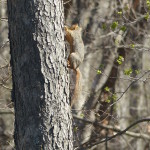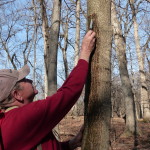by Winding Pathways | May 27, 2015 | Bugs, Nature
Few insects are as visible as fireflies winging over a lawn while blinking their lights on and off. Nearly everyone loves summer’s silent firefly light show, and they are a special delight for children.
Also called lightning bugs, these insects are most common in the eastern half of North America. Firefly larvae live under bark, wood, and leaves in shady damp locations. Although they are luminous people rarely see these larvae lights hidden in woodsy debris. Immature fireflies devour insects and other small ground dwelling creatures. Adults don’t feed. They fly around flashing their lights solely to attract a mate. Some firefly species blink yellow, while others blink green.
A delightful childhood experience is chasing and catching evening fireflies to watch them blink their lights on and off in a jar. Close examination reveals that they are brown or blackish beetles about a quarter to a half-inch long. After a bit of viewing free the captives and let them continue to spangle the night with friendly light.
Fireflies are one of many desirable insects killed by insecticides. Better to shun spray and enjoy these remarkable and beautiful animals.
Join Marion Patterson for a Firefly Labyrinth Walk at Indian Creek Nature Center on Friday, June 5th. Register through the Nature Center. 1-319-362-0664 or on-line
by Winding Pathways | May 27, 2015 | Nature
Take a walk on a damp morning following an overnight rain and worms will likely be crawling on the sidewalk
Nightcrawlers and other worm species are common in rural and urban areas throughout much of North America. Worms are so abundant that most people are amazed to learn that they are not native.
Most worm species originated in Eurasia and were inadvertently brought to this continent in soil surrounding nursery stock. Tiny eggs may have hitchhiked across the ocean in scraps of dirt. No matter how they got here worms arrived in early settlement days and quickly spread.
Nightcrawlers are the most visible worm species because they are large and often come to the surface. Most other species stay below ground. Crawlers are the most common worm sold for fish bait, and anglers dumping extra ones on the ground probably helped this animal expand its range.
Worms are frequently praised for their ability to aerate soil and break down plant residue into “castings”, or worm manure. Plants readily use this fertilizer, making worms the friend of farmers and gardeners. There’s no doubt that mixing by millions of earthworms helps make soil soft, rich and permeable to water. Ecologists take a dim view of these exotic invaders, which can reduce forest leaf litter and alter plant life in pristine ecosystems.
Going “nightcrawling” is a fun activity for children, whether or not the family goes fishing. Nightcrawlers come to the surface on damp spring nights to mate. Each individual is both male and female, and two join together to swap sperm before laying eggs. Visit the lawn after dark on a drizzly evening and quietly shine a dim flashlight’s beam on the ground. Two worms lying next to each other are likely mating. Leave them alone but gently grab any single worm and drop it in a can for future fish bait. Often a crawler will keep its tail in the ground. If a gentle pull doesn’t free it briefly stop tugging, and it will likely relax its grip and be easily captured. Be stealthy. Worms are spooked by vibrations in the ground, so wear soft shoes or go barefoot and move quietly.
Fish, birds, and many other animals eagerly devour worms, and they are now an important ecological component of lawns, gardens and farms.
by Winding Pathways | May 24, 2015 | Flowers/Grasses, Nature
One of our favorite wildflowers at Winding Pathways is the purple coneflower. It’s named for petals that radiate backward in a cone shape. The genus name Echinacea means “hedgehog” in Greek and derives from the prickly seed head that forms in late summer and persists into winter.
Native to woods’ edges and clearings throughout Eastern North America it has been widely planted and is now common in natural areas and cultivated yards across the continent. There are many coneflower species but the purple is probably the best known. It’s a gorgeous plant that pollinators love, is in bloom for a long time, and is amazingly easy to grow in both formal and naturalistic plantings. Deer seem to leave them alone. Few wildflowers are as well suited to backyards, especially those that have some sun.
Many people claim medicinal value from Echinaceas, but scientific evidence is mixed and uncertain. Enjoy it for its beauty, ease of growing and pollinator benefit.
A simple and free way to establish this perennial is to is to glean seeds. Keep an eye out for blooming coneflowers this summer in places were collection is allowed and return in the fall. Wearing leather gloves rub the prickly heads between fingers into a bag to free the seeds. Then, immediately scatter them in appropriate places in your yards. Coneflowers love moist soil and partial to full sun.
Coneflower seed is readily available at garden stores, and many nurseries sell potted young plants. Usually purple coneflowers bloom the second growing season after planting and need little care.
Two of our favorite nurseries for plants native to the Midwest are Ion Exchange and Prairie Moon Nursery.
by Winding Pathways | May 4, 2015 | (Sub)Urban Homesteading, Amphibians/Reptiles, Garden/Yard, Nature
The annual evening toad serenade has begun! From May into summer rural and urban folks can enjoy the loud trilling announcing toad lovemaking season. Nature’s summer music.
As amphibians, toads require standing water to reproduce but unlike many frogs they don’t need watery abundance. Toads lay their eggs in small pools that often dry up by summer. Eggs hatch quickly into tiny black tadpoles. While bullfrog tadpoles take two years to change into adult frogs, toad tadpoles are speedsters that transform into tiny hopping miniature adults by mid-summer. Often hundreds of these tiny creatures can be spotted seeking cool damp places to live.
Toads are voracious insect eaters, and gardeners delight in having them live under squash vines or tomato plants. Some people even construct tiny toad homes to encourage them to live in the garden.
We’re lucky to have a big toad living in a shed near our garden. His home is damp and cool with plenty of insects to keep him well fed.
According to the National Wildlife Federation, when pestered, toads eject a watery toxic substance from the parotoid glands. The toxin discourages dogs, raccoons or other hungry varmints intent on a meal from eating them. Few predators bother the placid toad. This bufotoxin can cause an allergic reaction in people. But humans do NOT get “warts” from toads.
Homeowners can encourage toads to take up residence. Building a small pond creates a toad magnet and maintaining a few damp places in the garden will provide toad homes. Avoid insecticides and, thus, encourage worms and insects for these intriguing animals to gorge on.
Kids love toads. When our children, Dan and Nancy, as small children delighted in watching them in our small backyard pond. Toads help transform a boring yard into a wondrous one!
by Winding Pathways | May 1, 2015 | Mammals, Nature
Squirrels are probably North America’s most acrobatic animals. They’re able to do seemingly impossible physical maneuvers.

Squirrels “wrists” articulate so they can climb agiley up and down.
One is hanging by their rear toes to snatch seeds from a hanging feeder. How do they do it?
Raccoons and house cats can climb up trees fairly rapidly but descending back to earth is a problem. Both must creep down tail first. It’s awkward and slow.
Squirrels, in contrast, can go up and down head first quickly and gracefully thanks to a special adaptation. Their ankles, or wrists, articulate. The squirrel may be heading down the trunk but its feet and claws point upward, enabling a good grip on the bark and a speedy dexterous descent.
Squirrels are outstanding tree climbers but once in a while they slip and fall. Twice at Winding Pathways we’ve seen squirrels fall from the top of big oaks. As they fall the hapless animals flattened themselves out and hit the ground like a swimmers belly flop. In both cases the animals shook themselves, looked around and scampered off unhurt. Imagine what would happen to a human falling 50 feet!
Next time you spot a squirrel hanging from a feeder or scampering down a tree examine its feet through binoculars. You may see upward facing feed on a downward facing animal. You Tube has some great close ups of squirrels paws and wrists. Enjoy the show!
by Winding Pathways | Apr 11, 2015 | Birds, Nature
Most woodpeckers are homebodies. Downy, hairy, red –bellied and most other woodpeckers are nonmigratory. Search a woodsy area and chances are they can be spotted or heard year round. Many will come to the backyard for a suet feast. Most woodpeckers are easy to observe and identify. They are noisy and move frequently making them easy to spot. They often call and drum as they move from tree to tree. The yellow-bellied sapsucker is an unusual woodpecker. It’s migratory in part of the country, secretive and challenging to find. Patient observation helps locate one hugging an April tree in the upper Midwest.
This colorful bird is about the size of the familiar hairy woodpecker. Despite its name the yellow belly is hard to see. More visible is a red crown and white stripe down the wings. The bird nests and summers from the Yukon across the continent to New England. Some spend the entire year in southeastern states down to southern Mexico, but many migrate north to nest. Winding Pathways is in Iowa where sapsuckers only pass through. They are most common in April.

Obvious evidence of sapsuckers with horizontal holes dripping sap.
Although more secretive than other woodpeckers sapsuckers are fairly common suburban and woodland birds. They leave unmistakable evidence of their presence.
Sapsuckers ingest sap and eat the insects that are attracted to this sticky substance. Birds drill holes in thin bark, especially of maples, birches and pines. Sap oozes out of the wound, and the birds return for nutritious dining. Usually the holes, called wells, are perfectly round with several forming a horizontal line. Sapsucker wells rarely harm a tree, although scars can remain on the bark for several years.
An outstanding information source for yellow-bellied sapsuckers and hundreds of other bird species is a website sponsored by the Cornell Laboratory of Ornithology. Go to allaboutbirds.org and enter in the species of interest. Photos, videos, maps, sound recordings and interesting tidbits of information will appear. The lab also offers a free smart phone bird identification app. Click on the website tab for information.


